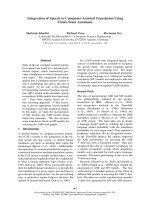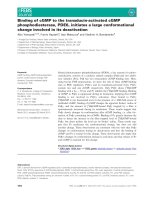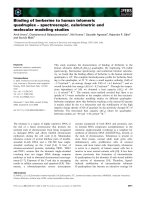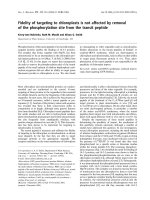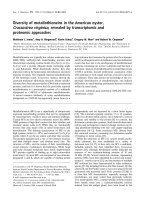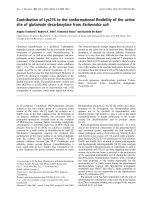Báo cáo hóa học: " Transformation of b-Ni(OH)2 to NiO nano-sheets via surface nanocrystalline zirconia coating: Shape and size retention" potx
Bạn đang xem bản rút gọn của tài liệu. Xem và tải ngay bản đầy đủ của tài liệu tại đây (388.81 KB, 6 trang )
NANO EXPRESS
Transformation of b-Ni(OH)
2
to NiO nano-sheets via surface
nanocrystalline zirconia coating: Shape and size retention
Ming-Yao Cheng Æ Bing-Joe Hwang
Published online: 11 November 2006
Ó to the authors 2006
Abstract Shape and size of the synthesized NiO
nano-sheets were retained during transformation of
sheet-like b-Ni(OH)
2
to NiO at elevated temperatures
via nano-sized zirconia coating on the surface of
b-Ni(OH)
2
. The average grain size was 6.42 nm after
600 °C treatment and slightly increased to 10 nm after
1000 °C treatment, showing effective sintering retar-
dation between NiO nano-sheets. The excellent ther-
mal stability revealed potential application at elevated
temperatures, especially for high temperature catalysts
and solid-state electrochemical devices.
Keywords Thermal stability Á Nickel oxide Á
Solid oxide fuel cell Á Surface coating Á Anode
Introduction
Handling shapes and sizes of nanostructured materials
is of great scientific interest as much of their superior
properties are directly linked to high chemical or
electrochemical active sites or specific nanostructures.
However, it is technologically difficult to apply nano-
structured materials at high temperatures since serious
sintering of materials would cause loss of active sites.
In order to preserve nanostructured natures of mate-
rials at elevated temperatures, retardation of sintering
behaviors was considered. However, only few reports
emphasized stabilization of the nanostructured mate-
rials at high temperatures [1–5]. Pang et al. showed the
size of SnO
2
nanoparticles could be controlled as small
as 3.5 nm even heat treatment at 600 ° C[3]. Wu et al.
found that surface-modified methylsiloxyl groups on
the metal oxide gel could prevent grain growth of
metal oxides during high temperature treatments and
excellent gas sensing properties were shown [4]. Lyu
et al. also showed that the thermal stabilities of
mesoporous metal oxides were improved by introduc-
ing silicon-contained hybrid Gemini surfactants as a
nano-propping agent [5].
Nevertheless, in electrochemical systems, dimension
of three-phase-boundary (TPB) length (the region that
reactants, electrode and electrolyte materials coexist)
plays an important role in the corresponding perfor-
mances. In solid-state electrochemical devices, such as
gas sensors and solid oxide fuel cells (SOFCs), high
temperature treatment could not be avoided during
fabrication and operation. Consequently, surface area
and TPB length are significantly decreased. Studies
aiming on how to retain surface areas and microstruc-
tures of electrodes during heat treatment are highly
needed [6–8]. Ozin et al. synthesized a series of
mesoporous materials for SOFC electrodes [9–13] and
showed better electrochemical performance on oxygen
reduction [13]. However, thermal stability of the
mesoporous materials needed to be further improved
[9, 13]. Liu et al. have also synthesized nanostructured
electrodes by a combustion CVD technique for SOFC
application and the electrode material about 50 nm in
grain size with higher performances were disclosed at
low operating temperatures [14].
M Y. Cheng Á B J. Hwang
Nano-electrochemistry Laboratory Department of
Chemical Engineering, National Taiwan University of
Science and Technology, Taipei 106, Taiwan, ROC
B J. Hwang (&)
National Synchrotron Radiation Research Center,
Hsinchu 300, Taiwan, ROC
e-mail:
Nanoscale Res Lett (2007) 2:28–33
DOI 10.1007/s11671-006-9025-5
123
Herein, we attempted to synthesize electrode mate-
rials with high thermal stability. Nickel oxide nano-
sheets were coated with small zirconia clusters on the
surface. Details of the nanostructure were also
explored.
Experimental
The standard process for synthesizing ZrO
2
-coated
NiO nano-sheets was described as follows. 0.03 mol
Ni(NO
3
)
2
(Acros) was dissolved in 50 ml de-ionized
water. Meanwhile, 0.12 mol NaOH (Acros) was dis-
solved in 50 ml de-ionized water followed by dropping
in to a Ni(NO
3
)
2
solution to form precipitates. The
precipitates were filtered and washed with de-ionized
water for several times and dried at 80 °C. The
crystalline structure of the dried precipitates was
characterized by XRD and was confirmed as hexagonal
b-Ni(OH)
2
. Then, 0.03 mol as-prepared b-Ni(OH)
2
was transferred into 100 ml 1-propanol (Acros) and
mixed for 5 h to form a well-dispersed solution. Later,
0.001 mol zirconium-1-propoxide (70 wt% in 1-propa-
nol, Aldrich) was added and the reactor was sealed
immediately followed by stirring for 3 days. Finally,
the solution was heated at 90 °C in an oil bath to
remove the solvent. The obtained dried gels were
transferred to furnace immediately for heating at the
target temperatures (600, 700, 800, 900 and 1000 °C)
with a heating rate of 5 °C/min and the holding time
was 1 h. For comparison, b-NiOH
2
mixed with the
same amount of zirconia was calcined at different
temperatures.
For characterization of the synthesized samples,
XRD (Rigaku D/Max-RC, Japan) with CuKa as
radiation source (k = 1.5406 A) was performed at
40 kV and 100 mA. TEM images were obtained by
JSM 1010 with accelerating voltage of 80 kV. High
resolution images were obtained by TECNAI F20
FEGTEM operated at the accelerating voltage of
200 kV. For TEM sample preparation, 0.01 g powder
was added into 20 ml ethanol followed by ultrasonic
treatment for 30 min. Later, 0.05 ml solution was
dropped on to a carbon-coated Cu grid and then dried
at 80 °C for TEM analysis. For nitrogen absorption
analysis, thesamples were heated at 250 °C in vacuum to
removed absorbed water before analyzing. The surface
areas were estimated according to BET equation.
Results and discussion
The basic concept for synthesis of the ZrO
2
-coated
NiO nano-sheets is illustrated in Fig. 1. First, b-nickel
hydroxide was well dispersed in the organic solvent.
Appropriate amount of zirconium n-propoxide was
then added to the solution. The added zirconium
n-propoxide reacted with the surface hydroxyl groups
of the Ni(OH)
2
:
Ni
surface
ÀðOHÞþZrðOC
3
H
7
Þ
4
! Ni
surface
À O
À ZrðOC
3
H
7
Þ
3
þ C
3
H
7
OH
ð1Þ
In Eq. 1, Ni
surface
represents the Ni
2+
ions on the
surface of the Ni(OH)
2
. The referred reaction was due
to the strong hydrolysis nature of inorganic alkoxide
with the hydroxyl groups. Then, the obtained Ni(OH)
2
underwent drying and heat treatment to form the NiO
materials with small ZrO
2
clusters coating on the
surface.
Fig. 1 Schematic illustration
of synthesis of ZrO
2
-coated
NiO nano-sheet
123
Nanoscale Res Lett (2007) 2:28–33 29
The as-synthesized Ni(OH)
2
precursors were first
examined by XRD (Fig. 2a). From the obtained XRD
pattern, it indicated the brucite-like crystalline struc-
ture of b-Ni(OH)
2
was obtained [15–18]. The sharp
(1 0 0) and (1 1 0) peaks with the average diameters of
the corresponding planes were respectively 9.23 nm
and 9.84 nm by the Debye–Scherrer equation, indicat-
ing the shape of the synthesized hexagonal b-Ni(OH)
2
grains close to regular hexagon with almost the same
dimensions of the two diagonals. Further, the average
thickness of the hexagonal grains could also be
estimated to be 2.65 nm according to (0 0 1) peak.
The results were also confirmed with the literatures
[19, 20].
The prepared Ni(OH)
2
precursors were first heated
at 300 °C for 1 h to form NiO (denoted as 300-NiO).
The XRD pattern was shown in Fig. 2(b1), indicating
the formation of NiO cubic structure. By estimating the
full width at half maximum (FWHM) of (2 0 0) peak,
the thickness of 300-NiO was 3.95 nm. Further, the
crystalline thickness estimated by (1 1 1) and (2 2 0)
peaks were 4.06 and 4.74 nm, respectively. From the
estimated crystalline thicknesses by different directions,
the shape of the 300-NiO grain was close to spherical.
However, from the TEM image of 300-NiO (Fig. 3a),
tremendous amounts of sticks and platelets were
observed, implying that the morphology of the synthe-
sized b-Ni(OH)
2
was maintained after 300 °Ctreatment
with the thickness and length of the sticks around
2–3 nm and 10 nm, respectively, close to that of the
synthesized b-Ni(OH)
2
. The inconsistency between
XRD and TEM results suggested that the observed
nano-sheets were possibly formed by stacking of NiO
nano-grains. After heating the synthesized b-Ni(OH)
2
at
600 °C, nano-sized nature of the synthesized b-Ni(OH)
2
was no longer retained in the formed NiO (denoted as
600-NiO), which was first revealed by the sharp peaks in
the XRD pattern shown in Fig. 2(b2). The calculated
grain size according to (2 0 0) peak was around
25.41 nm, which was also evidenced by TEM image
(Fig. 3b). Besides, grains of 600-NiO were cubic-like
instead of nano-sheets, which was due to the sintering of
the nano-sheets after 600 °C heat treatment.
On the other hand, the XRD pattern for the
600 °C-treated ZrO
2
-coated NiO was shown in
Fig. 2(b3). First, pure cubic NiO phase was revealed
and monoclinic ZrO
2
was not observed. It was
possible that the amount of the ZrO
2
was much less
compared to that of NiO. The broadening of the
peaks indicated small NiO grains were maintained by
the surface ZrO
2
. Again, according to the FWHM of
(2 0 0) peak of the ZrO
2
-coated NiO, the grain size
was 6.42 nm. TEM images of the ZrO
2
-coated NiO
also showed sticks and hexagonal sheets the same as
that of 300-NiO, except some small spherical grains
were observed (Fig. 3c). Even after higher tempera-
ture treatment, the sticks and hexagonal sheets were
still observed, excluding the thickness of the nano-
sheets increased (Fig. 3d).
To clarify the nanostructure of the materials, high
resolution TEM image of the 600 °C-treated ZrO
2
-
coated NiO was taken and analyzed. It was clearly
shown that hexagonal sheet was coated by small
Fig. 2 XRD patterns of (a) the synthesized b-Ni(OH)
2
,(b1) 300-
NiO, (b2) 600-NiO, and (b3) 600 °C-treated ZrO
2
-coated NiO
123
30 Nanoscale Res Lett (2007) 2:28–33
spherical particles (Fig. 4a). The size of the particle
was around 4–6 nm. Furthermore, the lattice image
of the coated spherical particle showed the d-spacing
was 0.36 nm. It indicated (0 1 1) direction of the
monoclinic ZrO
2
(Fig. 4b). The d-spacing of the
hexagonal sheet was 0.24 nm, which indicated (1 1 1)
direction of the cubic NiO (Fig. 4c). Further analyz-
ing the composition of spherical-particle-coated
nano-sheet by EDX spectra, it revealed that the
composition of the portion without spherical particles
was nickel-rich (Fig. 4d) and that with spherical
particles was zirconium-rich (Fig. 4e). Since the
amount of ZrO
2
is only 1/30th of that of NiO (in
mol), the thickness of ZrO
2
layer would be much
smaller than the size of NiO nanoparticles. It is
suggested that the ZrO
2
particles shown in Fig. 4a
and b are exceptional, rather than typical, in size.
Zirconium 1-propoxide would mainly react with the
hydroxyl group on the surface of b-Ni(OH)
2
via
hydrolysis and condensation reactions to form ZrO
2
layer. However, the ZrO
2
particles are extraordinary
formed via the hydrolysis and condensation reactions
of zirconium 1-propoxide in solution.
The estimated NiO grain sizes of the synthesized
ZrO
2
-coated NiO at different temperatures were
shown in Fig. 5. It was obvious that the retention of
NiO grain size was effective when comparing with that
of NiO by heating physical-mixed Ni(OH)
2
–ZrO
2
.
After 1000 °C treatment, the grain size of ZrO
2
-coated
NiO was retained around 10 nm where that of the
physical-mixed NiO–ZrO
2
was larger than 50 nm.
Even the sintering among the ZrO
2
-coated NiO
nano-sheets was still occurred, however, it was effec-
tively retarded by the surface ZrO
2
.
The fact of the nano-sized nature of the ZrO
2
-
coated NiO could also be evidenced by nitrogen
absorption measurement. For the 600 °C-treated
ZrO
2
-coated NiO, the BET surface area is as high as
120.53 m
2
g
–1
and almost seven times higher than that
of the 600-NiO (17.52 m
2
g
–1
). Even after 1000 °C
treatment, BET surface area of the ZrO
2
-coated NiO
was still as high as 42.64 m
2
g
–1
.
From the above analysis, the formation and sinter-
ing behavior of NiO were concluded. First, the hexag-
onal b-Ni(OH)
2
was treated at low temperature of
300 °C to form the hexagonal NiO nano-sheet which
was stacked by NiO grains. However, the size of NiO
was seriously increased and the sheet-like shape was
collapsed soon after heat treatment at the temperature
slightly higher than 300 °C.
Fig. 3 TEM images of (a)
300-NiO, (b) 600-NiO, (c)
600 °C-treated ZrO
2
-coated
NiO and (d) 1000 °C-treated
SS-NiO
123
Nanoscale Res Lett (2007) 2:28–33 31
On the other hand, the ZrO
2
-coated b-Ni(OH)
2
was
also treated at temperature of 300 °C to form the
ZrO
2
-coated NiO. Retention of nano-sheets was
clearly shown even heating at higher temperature
compared to the uncoated one. The particular behavior
of the synthesized ZrO
2
-coated NiO nano-sheets was
proposed by the surface ZrO
2
nanoparticles that
limited the sintering among the NiO nano-sheets.
Even after 1000 °C treatment, the shape and size of
the nano-sheets were still preserved expect the slightly
increase of the thickness of the nano-sheets. However,
the estimated size of the NiO grains was not consistent
with the size and shape observed by TEM. It was
proposed to be caused by the observed nano-sheet was
stacked by NiO grains.
Fig. 4 (a) High resolution
image of ZrO
2
-coated NiO:
(a) whole image, (b) and (c)
are enlarging part of
hexagonal nano-sheet and
surface ZrO
2
particle,
respectively. (d) and (e) are
EDXs spectra for ZrO
2
-
coated NiO without and with
surface ZrO
2
, respectively
Fig. 5 Relationship of calculated grain sizes of physical mixed
NiO–ZrO
2
(asterisk) and ZrO
2
-coated NiO (filled circle) with
temperatures
Table 1 BET surface areas of ZrO
2
-coated NiO and 600-NiO
Materials BET surface area(m
2
g
–1
)
600-NiO 17.52
600 °C-treated ZrO
2
-coated NiO 120.53
800 °C-treated ZrO
2
-coated NiO 85.11
1000 °C-treated ZrO
2
-coated NiO 42.64
123
32 Nanoscale Res Lett (2007) 2:28–33
Conclusions
In this work, we have demonstrated that the retention
of shape and size of b-Ni(OH)
2
nano-sheets during its
transformation to the NiO nano-sheets was achieved
by the developed method. The nanostructure was
retained even after 1000 °C treatment, which was due
to the existence of ZrO
2
clusters on the surface of the
NiO nano-sheet. The development also opens up a new
way to control the shape and size of metal oxides at
high temperatures, which is a critical issue in the
development of anode materials for SOFC application.
Acknowledgement The authors thank National Science
Council (NSC-94-2120-M-011-002 and NSC-94-2214-E-011-010,
Taiwan, R.O.C.) and National Taiwan University of Science and
Technology for financial supports. FEG-TEM support from
Institute of Material Science and Engineering, National Sun Yat-
sen University is also acknowledged.
References
1. C. Nayral, T. Ould-Ely, A. Maisonnat, B. Chaudret, P. Fau,
L. Lescouze
`
res, A. Peyre-Lavigne, Adv. Mater. 11, 61 (1999)
2. E.R. Leite, I.T. Weber, E. Longo, J.A. Varela, Adv. Mater.
12, 965 (2000)
3. G. Pang, S. Chen, Y. Koltypin, A. Zaban, S. Feng,
A. Gedanken, Nano. Lett. 1, 723 (2001)
4. N.L. Wu, S.Y. Wang, I.A. Rusakova, Science 285, 1375
(1999)
5. Y.Y. Lyu, S.H. Yi, J.K. Shon, S. Chang, L.S. Pu, S.Y. Lee,
J.E. Yie, K. Char, G.D. Stucky, J.M. Kim, J. Am. Chem. Soc.
126, 2310 (2004)
6. S.P. Jiang, Y.Y. Duan, J.G. Love, J. Electrochem. Soc. 149,
A1175 (2002)
7. E.Z. Tang, T.H. Etsell, D.G. Ivey, J. Am. Ceram. Soc. 83,
1626 (2000)
8. U.B. Pal, S.C. Singhal, J. Electrochem. Soc. 137, 2937 (1990)
9. M. Mamak, N. Coombs, G.A. Ozin, Adv. Funct. Mater. 11,
59 (2001)
10. M. Mamak, N. Coombs, G.A. Ozin, Chem. Mater. 13, 3564
(2001)
11. M. Mamak, N. Coombs, G.A. Ozin, Adv. Mater. 12, 198
(2000)
12. M. Mamak, N. Coombs, G.A. Ozin, J. Am. Chem. Soc. 122,
8932 (2000)
13. M. Mamak, N. Coombs, G.A. Ozin, J. Am. Chem. Soc. 125,
5161 (2003)
14. Y. Liu, S. Zha, M. Liu, Adv. Mater. 16, 256 (2004)
15. M. Rajamathi, P.V. Kamath, R. Seshadri, J. Mater. Chem.
10, 503 (2000)
16. P. Jeevanandam, Y. Koltypin, A. Gedanken, Nano Lett. 1,
263 (2001)
17. Z.H. Liang, Y.J. Zhu, X.L. Hu, J. Phys. Chem. B 108, 3488
(2004)
18. Y.L. Lo, B.J. Hwang, Langmuir 14, 944 (1998)
19. A.M. Fojas, E. Muphy, P. Stroeve, Ind. Eng. Chem. Res. 41,
2662 (2002)
20. F. Barde
´
, M.R. Palacin, Y. Chabre, O. Isnard, J M.
Tarascon, Chem. Mater. 16:3936 (2004)
123
Nanoscale Res Lett (2007) 2:28–33 33

